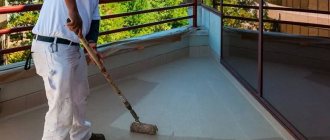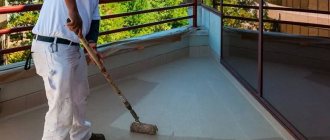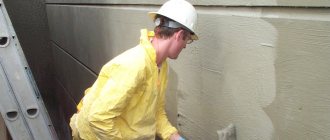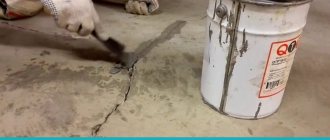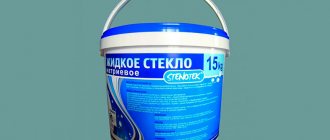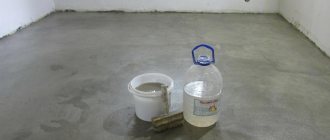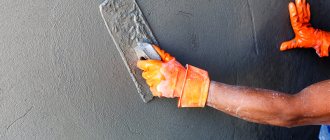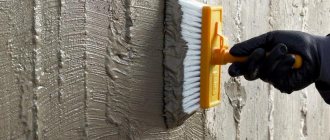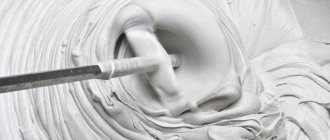Let's understand what liquid glass is. What does it consist of and what are the main advantages. Read to the end and learn everything about this material - from the formula to its use in construction. This information will allow you to “not swim” in matters of liquid glass for concrete or wood when concluding an agreement with a construction company. This will also help optimize construction costs without compromising quality.
Sodium silicate adhesive for concrete surfaces Source 55elmirador.com
Using ZhS
The use of liquid glass in construction is due to its qualitative properties. It increases water resistance, which is especially important when constructing foundations for hydrological structures (fountain, pool, etc.). It also increases the heat-resistant qualities of bases for stoves, fireplaces and other heating devices.
Coating insulation of the pool bowl with glue Source dm-art-design.ru
The more liquid glass you add to concrete, the faster it will set, for example:
- if the material is 2%, then you can walk on the solution after a day;
- at 10% – after 6 hours.
Excellent waterproofing and heat-resistant mixtures are prepared from this glue. The primer is made from cement, water and liquid glass. Excellent insulation is obtained from glue and sand. The use of liquid glass has shown excellent results on the walls of wells, wet tunnels and basements.
The refractory mixture is made from sand and cement with the addition of office glue. The walls of the fireplace and stove are treated with it using a wide brush. In addition, you can use liquid glass for wood in the form of an antiseptic. To do this, the glue should be diluted with water.
Wood treated with glue Source www.cedar-stuff.com
Liquid glass is applied to a vertical surface in an even layer using a regular paint brush; on a horizontal surface it is easier to pour it and spread it with a squeegee or spatula. If the coating with liquid glass is supposed to be double-coated, then the first layer must dry completely.
Purpose and scope of liquid glass in other areas of production
Construction is the main area of application of liquid glass, but it is far from the only one. The examples below demonstrate this.
Helpful advice! The sodium silicate solution hardens very quickly, almost instantly, so experienced builders recommend not adding it to the cement composition, but using it as an impregnation on finished structures.
Sodium silicate can be used to waterproof wood
The use of liquid glass glue is wide and universal. The high degree of adhesion of the silicate solution allows it to be used for gluing various materials, including fiberboard, thin sheets of chipboard, plywood, ceramics, and cardboard.
Liquid glass is used to remove dust from the surface of cement floors in garages and other utility rooms. The work is carried out by impregnating the base with a mixture of water and liquid glass. The solution penetrates the concrete 3-4 mm deep, where it polymerizes, forming a smooth surface on top that does not collapse. Thus, cement dust does not form on it.
Silicate glue is used for waterproofing wood. Liquid glass is widely used for wood. The product is mixed with water and applied to the surface where a moisture-protective layer is formed. The coating also prevents the penetration of air and insects.
Liquid glass is used in gardening. An aqueous solution of this substance is used to treat cuts on trees after cutting down branches. A dense airtight layer protects plant wounds from dangerous bacteria and prevents the process of rotting.
Plumbers use liquid glass to connect pipes as a sealant
Silicate adhesive is used to create an airtight coating in plumbing fixtures. As a sealant, liquid glass is applied at the junction of water supply and sewerage pipes. For this purpose, use the product in its pure form.
Liquid glass - what is it?
This term refers to a water-soluble mixture of potassium or sodium silicates. Lithium silicates are used for electrode coating. The material has a viscous structure and consists of tiny crystals. When they hit the surface, they increase in size and fill microscopic cracks and pores. This creates a water-repellent and heat-resistant layer.
Penetrating waterproofing: applying a solution with LC Source obustroeno.com
The formulas of liquid glass or silicate glue are as follows: K2O(SiO2)n or Na2O(SiO2)n.
This glue was first obtained by the German mineralogist and chemist Jan Nepomuk von Fuchs in 1818 by the action of alkali on silicic acid. In addition to waterproof concrete and cement, potassium or sodium liquid glass is used for:
- preparing fireproof paint;
- gluing linoleum and PVC boards;
- self-leveling floors;
- antipyrrhenes for wood;
- impregnation of fabrics;
- securing weak soil;
- cellulose gluing.
If you add liquid glass to a cement solution, then after hardening you will get a very durable monolith.
Advantages of the material
The material has gained great popularity due to a number of advantages, including:
- High degree of adhesion . Thanks to its fluid consistency, it penetrates into the smallest cracks and pores, filling the necessary space. Liquid glass easily adheres to surfaces, creating a reliable base.
- Waterproof . Thanks to the film created by the silicate material, the waterproofing layer is smooth, complete and water-repellent.
- Economical . Consumed in minimal quantities, especially in combination with cement mortar.
- Affordable price . Its properties are not inferior to expensive waterproofing materials, being a cheaper alternative.
- Long service life . Provided that the insulation work is carried out conscientiously, the liquid glass surface will last up to 5 years. This period can be increased by covering the finished layer with paint.
Attention! Liquid glass for waterproofing allows you to work even in conditions of high humidity.
Proportions and mixing
Depending on the purpose of use, the proportions of the various components of the solution are chosen. Ready-made mixtures intended for a particular task are more expensive, so solutions prepared directly at a construction site are often used.
Stationery glue on the floor Source fundamentplus.com
Composition for coloring
The effect of silicates on coloring pigments significantly limits the number of shades. Potassium silicate is used to prepare coloring compositions - it gives a more uniform color, unlike sodium. Such dyes are produced in ready-made versions; you only need to combine 2 components.
See also: Projects of houses with second light
Primer
To get a good primer, glue and cement should be taken in equal quantities. This coating will significantly strengthen the concrete foundation. Lighter solutions are made for tiles.
Impregnation
To increase the service life of elements and structures, an aqueous adhesive solution is used in a ratio of 1/5. Impregnate with a spray gun or brush. Small items can be completely immersed in the mixture.
Waterproofing
To protect concrete from water, prepare a solution of sand, cement and glue in equal parts. Water is added until the mass becomes homogeneous and plastic.
Fire protection
Masonry mortar with heat-resistant properties consists of cement and sand in a ratio of 1/3. Water is added until a plastic consistency is obtained, silicate glue is added last and makes up approximately 20% of the mass.
Do-it-yourself waterproofing solution preparation technology
At the preparation stage, it is necessary to have enough liquid glass to be added to the solution and applied in a layer of up to 3 mm. Cement mortar and liquid are often mixed based on a ratio of 10 to 1. For use as waterproofing, such a concentration will be sufficient. When using the ratio of liquid glass to cement mortar in mass equivalent, it is important to take into account the density of the composition.
Weight depending on density:
- glass – 1.5 kg/l;
- mixture of sand and cement (1 to 4) – 2.6-2.7 kg/l;
- concrete – 2.2-2.5 kg/l, for lightweight concrete the weight is different;
- quartz type sand - 1.5-1.7 kg/l, in the form of a mound - 1.5 kg/l, and compacted sand - 1.7 kg/l.
By maintaining the proportion of silicate in concrete, the waterproofing characteristics of the composition increase, which is especially important for surfaces in contact with ground and water. To impart strength to concrete, it is recommended to add silicate not only to the solution, but also to use it as an external coating.
The material is widely used for waterproofing wells, building walls in humid regions and hydraulic structures. For wells and similar structures, it is recommended to use fine sand with cement in equal proportions. Before application, the main preparation is carried out - surface treatment with silicate.
If the surface part of the supporting structure has been impregnated with a solution, you should not wait until the composition has completely hardened. After the concrete is formed, the surface treated with silicate is covered with a film, which impairs adhesion. Even primer does not adhere well to frozen glass.
Video description
In the video, testing wood treated with liquid glass for combustibility:
Antiseptic
To prevent rotting and damage to surfaces by fungus and mold, structures are treated with liquid glass diluted with water in a ratio of 1/1. Use glue for processing concrete and wood.
Repair composition
Liquid glass, cement and sand are taken in a ratio of 1/1/3. Water is added until a sufficiently thick consistency is obtained so that the solution does not flow out of the cracks when they are eliminated. The mixture is also used when sealing joints and pouring screeds.
Mixing the solution
To properly mix a solution using liquid glass, you must follow the recommendations for certain mixtures for treating and repairing surfaces. Dry ingredients and glue with water are mixed separately.
Screed with ZhS Source i9.photo.2gis.com
See also: Specialize in the design and construction of small forms
Dry components are added in parts to the solution, and not vice versa. For greater plasticity, the volume of water is increased. The mixture is applied to the surface, taking into account finishing technologies.
General recommendations for work
- Before you start working with a particular surface, you should first clean it completely of any contaminants.
- Before applying a new layer, give the previous one time to dry.
- The glue is applied with a brush or roller; sometimes, in order to create a protective coating, a spatula is used.
- The surface treated with glue must dry for at least a day, so try not to rearrange the furniture until the required time has elapsed.
- If you intend to use cement mortar using liquid glass, then it is mixed right before use and then applied for 20 minutes.
- When working with liquid glass, wear clothing designed for this purpose. When finished, thoroughly wash your hands and any tools used before the materials harden.
As for the cost, silicate glue is really more affordable than other synthetic glues or impregnations. The material is sold in almost every construction or hardware store. Sometimes, to make the glue set even faster and last longer, a special hardener is added to it.
How long does it take for liquid glass to dry?
The hardening time of liquid glass depends on how it was used. If in its pure form, it will harden in 10 minutes, if as part of a mixture, then 12 hours.
Application of liquid glass
When working with potassium or sodium liquid glass, you should use protective equipment - a special suit and mask. If the mixture gets into your eyes or skin, rinse with plenty of water. Since the solution sets quickly enough - within 30 minutes, you need to calculate the one-time volume of the batch. After half an hour, you can apply the next layer.
Basement waterproofing
The basement is an important structure, so protecting it from moisture is the main condition for a favorable atmosphere in the house and the safety of food. Most often in the basement there is poor insulation of joints and the presence of cracks.
Basement insulation diagram Source moydomik.net
To get rid of them:
- first clean the seams and cracks from various inclusions and dust;
- then prepare a solution of silicate glue and cement in a ratio of 1/20, add water until a plastic consistency is obtained;
- then apply the mixture to the seams or cracks and level them with the same solution;
- After this, coat with water using a brush.
After a day, it is better to apply a layer of glue to the repair site.
Treatment of a concrete well, swimming pool
First, the concrete is cleaned with a brush to remove dirt and dust. After this, apply one layer of impregnation with a roller or brush. After half an hour, apply the second layer. Liquid glass should lie evenly, without gaps. Then prepare a solution from a cement mixture and silicate glue in a ratio of 9/1 and apply it with a spatula in 20 minutes, taking into account the low viability of the solution.
The use of liquid glass in everyday life, creativity and decoration
Liquid glass helps solve a large number of household problems, which has made it popular in everyday life. It is used to remove scale, clean dishes, remove stains from clothes, glue glass and ceramics, and use it to protect metal from corrosion. For example, for wear resistance and protection from the effects of fire, costumes and curtains in the theater, as well as curtains in public institutions, are covered with liquid glass. Reviews from housewives characterize it as a universal remedy in the fight against scale and fumes. For example, the oldest frying pan can be restored to its original appearance. A simple recipe is used for this.
Liquid glass is dissolved in boiling water in a ratio of 1:25 and a frying pan is boiled in the solution for 2 hours. Some of the carbon will go away, and the rest will be easy to clean with a knife and a metal sponge. The effect of the solution will be enhanced by adding soda ash and laundry soap. In this way you can easily clean any dishes made of metal, porcelain and glass. The cooking time can be reduced to 10 minutes.
The use of liquid glass in decoration allows you to create elegant stained glass windows and mirror panels with mosaics. In addition to the above, silicate solutions are used to organize self-leveling floors in art design.
Using liquid glass you can clean dishes from burning and scale
Helpful advice! Using silicate glue, earthenware and glass products are restored. However, it should not be used for gluing dishes intended for food.
Liquid glass is actively used in creativity. With its help you can easily glue a wide variety of materials: paper, cardboard, leather, fabric, rubber. Therefore, this substance is often simply irreplaceable in needlework. Liquid glass is an excellent tool for enhancing shine and protecting the surface of cars. However, in this case, a special composition is used, which differs from the formula of conventional silicate glue.
General recommendations for treating concrete bases with liquid glass
The work of processing the concrete base is done quickly - the ready-made liquid silicate adhesive can simply be mixed using a construction mixer. Work should be carried out at temperatures above plus 5 degrees. After collecting the glue, the container is tightly closed. And :
- there is no need to treat external surfaces if frost is expected;
- if there is ice or frost on the base, no work is carried out;
- When processing horizontal areas, puddles are unacceptable.
Any surface must be properly prepared - silicate glue is applied only to dry and clean surfaces. The top loose layer (ironization and cement laitance) is removed using various tools and units. For large areas - this is a grinding machine, sandblasting and shot blasting machine. For hard-to-reach places and in junction areas - hand tools. The resulting sludge and debris are cleaned out with stiff brushes and a construction vacuum cleaner.
Cleaning up garbage with a construction vacuum cleaner Source kwitka.com.ua
How to prepare a solution with liquid glass
The ratio of solvent to glass can be varied. Here you should study the instructions on the packaging. Because an individual brand may have different requirements. It is better to dissolve the material using a construction mixer, then it will be easier to obtain a homogeneous solution.
It is better to dissolve the material using a construction mixer, then it will be easier to obtain a homogeneous solution.
Advantages and disadvantages
Liquid glass has its advantages and disadvantages. The first include:
- low cost;
- low consumption of glue in solutions;
- resistance to precipitation;
- ease of use;
- good adhesion (penetrates 2-3 mm into concrete);
- durability of concrete and protective film.
Along with this, silicate adhesive prevents the accumulation of static electricity and is resistant to acids.
Protective film on wood countertops Source woodspil.ru
Along with the advantages, the material also has disadvantages:
- The protective film is not strong enough and is destroyed by mechanical stress.
- Not applicable on brick.
- When waterproofing the foundations of buildings and structures, rapid crystallization of the composition with the addition of LC occurs.
If the proportions of components in solutions are not observed, it is impossible to obtain the expected result.
Tools
0 votes
+
Vote for!
—
Vote against!
Among the large number of options for waterproofing, liquid glass stands out with many advantages. We will consider the features, application and characteristics of this material further.
Table of contents:
- General concept and advantages of liquid glass
- Scope of use and types of liquid glass
- Recommendations for working with liquid glass
- Liquid glass - operating instructions and application
- Liquid glass for waterproofing - nuances in application
- Recommendations for choosing and purchasing liquid glass
- Tips for preparing solutions based on liquid glass
General concept and advantages of liquid glass
The term liquid glass refers to a solution based on water and sodium or potassium silicates. It has a viscous structure, and therefore copes well with work related to waterproofing.
If we consider the composition of liquid glass, then small crystals are easily visible in it, which, after being applied to the surface, enlarge, filling small cracks. It is thanks to this structure that liquid glass is characterized by a water-repellent and airtight effect. Liquid glass is used in a variety of fields due to its environmental friendliness and harmlessness.
If we talk about the principle of action of liquid glass, then it has adhesive ability. This manifests itself due to the fact that liquid glass molecules enter the molecules of the solid material, which do not have close bonds with each other, which penetrate into the interior of the solid molecules and thus their adhesion occurs.
Liquid glass resembles rubber, which is in a liquid state. After its application, the surface becomes water- and airtight. The composition of liquid glass includes calcium or sodium silicate, to which soda or quartz sand has been added. During the production of liquid glass, it is crushed, fired and re-crushed into a powder mass.
The liquid glass mixture has the following properties:
- water repellent - that is, water repellent;
- antiseptic - prevents the formation of bacteria;
- antistatic - no electrification;
- hardener - the material on which liquid glass is applied becomes durable;
- acid protectant;
- fireproof material resistant to fire.
This material has a large number of advantages; studying reviews about liquid glass, the following advantages are highlighted:
1. Liquid glass is a very liquid adhesion, which, due to its fluid state, can easily penetrate into the smallest pores and cracks. It also has strong adhesion to the surface and easily covers both concrete and wooden substrates.
2. The creation of a liquid waterproof film is another advantage of this material. Regardless of how liquid glass is applied, a complete and moisture-resistant surface is obtained.
3. Low consumption of liquid glass is also its advantage. Especially when it is added to cement mortar, as a penetrating type of waterproofing.
4. If we compare the cost of liquid glass with other waterproofing materials, then it successfully outperforms them, since it has the most affordable cost among alternative options.
5. Waterproofing with liquid glass has a service life of 5 years. This material gradually self-destructs, but if you cover the waterproofing with a protective layer of paint, it will last much longer.
6. It is the only insulator that allows you to work even in conditions with high humidity.
Despite the large number of advantages of liquid glass, there are also a number of its disadvantages:
1. It has a limited scope of use - it is used as waterproofing of concrete or wooden surfaces. It is prohibited to use liquid glass solution for waterproofing brick surfaces, due to their possible destruction.
2. The film that liquid glass forms is quite fragile, so it must be used as a combination of several types of waterproofing.
3. Difficulty of application - the material dries very quickly and forms a film, so work skills are required to make waterproofing efficiently.
Liquid glass photo:
Scope of use and types of liquid glass
As mentioned above, liquid glass is not suitable for all materials, but its scope of application is quite wide. Liquid glass is used in the following cases:
1. If you add liquid glass to a cement mortar, you will get a reliable coating, protected from moisture and the negative influence of groundwater, if the mortar is used to fill the foundation.
2. Liquid glass is used for waterproofing swimming pools or artificial ponds.
3. Used as an adhesive for gluing various types of building materials.
4. Used to produce mortars with fire-resistant or acid-resistant characteristics.
5. If there is a problem with mold or mildew in the house, several layers of liquid glass should be applied to previously cleaned affected areas.
6. Use a solution of liquid glass as an adhesive to repair paper, cardboard, wood or porcelain products.
7. To seal weak joints or plaster a pool, a solution of cement and liquid glass is perfect. But keep in mind that you need to work with such a solution quickly, since after a while it thickens and becomes unusable.
8. If you plan to build a house on weak soils, which will shrink in a few years, then a solution of cement with liquid glass is used for injections, which are injected into the upper layers of the soil.
If we consider the scope of using liquid glass as waterproofing, we will highlight the following options:
1. Liquid glass is used as coating waterproofing. Before installing roll waterproofing, several layers of liquid glass are applied to the surface. The solution perfectly fills all cracks and pores of the concrete surface.
2. A solution of liquid glass with cement is used to eliminate serious leaks or as waterproofing of joints in prefabricated foundations.
3. Liquid glass is part of concrete; it improves its solidity and provides waterproofing.
Two types of liquid glass are common:
- potassium,
- sodium
The first option has good adhesiveness and is used for waterproofing the foundation parts of a building. Included in antiseptic impregnations. Interacts well with mineral-based formulations.
The second type is a metal additive and helps improve the stable characteristics of glass. Resistant to acids. It does not have the typical shine of glass, so it is used as a surface coloring.
Recommendations for working with liquid glass
If liquid glass is to be applied to a surface, then it must first be diluted with water in the ratio of 200 grams of water per 100 g of material. In this case, no more than 300 g of solution will be required per square meter.
Waterproofing with liquid glass is used on walls where the plaster has weathered or on concrete walls with uneven surfaces. Using liquid glass will strengthen and level the surface, and also create a protective antiseptic layer.
There are several methods for applying this material. Before using liquid glass, the surface should be degreased, cleaned and leveled as much as possible. If impregnation of concrete is required at a shallow depth of up to three millimeters, then use a spray gun or brush. If deep impregnation of more than two centimeters is necessary, at least three layers of solution must be applied.
If liquid glass is used to waterproof a floor or concrete screed, then one liter of material is added to 10 liters of concrete mortar. Also, liquid glass is an excellent anti-corrosion impregnation; it is used to treat metal structures. To ensure the protection of the pool from water leakage, the application of a solution of liquid glass is also used. Liquid glass is part of fire-resistant paints.
Liquid glass - operating instructions and application
To prepare a solution of concrete and liquid glass, the proportions are one to ten. This mixture is used for waterproofing wells, swimming pools, bathrooms, basements and other structures made of concrete or reinforced concrete.
Applying the material is a fairly easy process, during which a protective layer is formed on the surface, which acts as a barrier to moisture penetration.
The facade of a building should not be treated with such a raster if it is planned to be painted further, since the adhesion of the paint and the wall will be low, and the paint will practically not lie on the surface.
When working with liquid glass, it is recommended to use special clothing. To make a traditional Russian stove, a solution based on cement and liquid glass is used. The ratio of components sand: cement: silicate glue is 3: 1: 0.2. The result is a mixture that resembles dough, is very easy to work with and has good performance characteristics as a material for constructing an oven.
The use of silicate glue, to which liquid glass is added, is very popular among builders. It is used for gluing tiles made of polyvinyl chloride or linoleum. Water pipes are coated with liquid glass to prevent water leakage and seal joints. To make protective non-flammable fabric, liquid glass is also used as an impregnation.
Liquid glass is a universal material that is even used in gardening. When small wounds appear on trees or bushes, they are covered with liquid glass. It is an excellent antiseptic and prevents the development of harmful bacteria.
Liquid glass for waterproofing - nuances in application
Before applying liquid glass to the surface, it must be cleaned of dust and dirt.
Then follow these steps:
1. Apply liquid glass to the surface with a brush or roller.
2. Wait 30 minutes and apply another coat. Try to do this evenly without allowing gaps to appear.
3. The next stage is preparing the protective layer. Make a regular mortar based on cement and sand. Add liquid glass to it, in a one to one proportion.
4. Stir and apply to the surface at a very fast pace. This solution should not be applied a second time, since the functions of liquid glass will not be performed.
5. Mix gradually, apply the solution to the surface using a cement spatula in a standard layer.
And remember, before using liquid glass, you should inspect it for cleanliness, foreign objects or lumps. The shelf life of liquid glass is quite long, and the temperature range is wide. Therefore, even if it is stored outside in the winter, this will not affect its quality in any way.
Let's consider applying liquid glass to the foundation:
- clean the surface from various types of contaminants using sandpaper;
- Use a roller to apply the solution evenly;
- apply a second and, if desired, a third layer after 30 minutes;
- insulate the foundation with mineral wool or polystyrene foam.
Recommendations for choosing and purchasing liquid glass
To buy liquid glass, contact any hardware store or market. Among the large number of liquid glass manufacturers, there is practically no difference in its composition. Therefore, which manufacturer to choose is a personal matter. But, in principle, even the cheapest material has the same characteristics as the expensive one.
Liquid glass price starts from $2 per 10 liters. As you can see, the material is really not expensive, but at the same time multifunctional.
If you make a choice between sodium or potassium type liquid glass, then each option has its own advantages and disadvantages.
Potassium liquid glass is used for foundations, as it is more viscous, and sodium liquid glass is used for waterproofing other construction objects.
Tips for preparing solutions based on liquid glass
1. There is an option for preparing a primer based on liquid glass. It is not recommended to treat walls with a pure solution of liquid glass. Thanks to its antiseptic properties, liquid glass does an excellent job of priming, preventing the formation of mold and mildew, and increasing adhesion.
To prepare a primer based on liquid glass, you must have:
- cement,
- liquid glass,
- water.
The amount of cement and liquid glass is the same, and the water should make the mixture liquid, suitable for applying to the wall with a roller. First, cement is mixed with water, and then liquid glass is added. To do this, use a drill or a construction mixer. It is recommended to use the solution within half an hour; if it has hardened, add a little water.
2. To prepare a waterproofing or fire-resistant solution, take a little sifted sand. Equal parts of water, cement, sand and liquid glass are mixed. This mixture does an excellent job of waterproofing wells.
3. Antiseptic solutions help prevent the appearance of microorganisms or bacteria. Its preparation is a simple process. To do this, mix liquid glass with water one to one and cover, for example, a wooden surface with this solution. This is much cheaper than traditional moisture-resistant impregnations, but no less effective.
4. To make impregnation from liquid glass, which is used to cover walls, ceilings or floors, four hundred grams of liquid glass should be diluted in one liter of water.
Liquid glass video:
Ensuring safety precautions
The glue is non-toxic, non-flammable and non-explosive. The prepared mixtures are stored in a dry, cool place at a positive temperature of 5 to 40 degrees.
Safety precautions and precautions Source beton-house.com
Silicate glass is frost-resistant and can withstand temperatures down to minus 34 degrees. The material can withstand 5 freeze/thaw cycles without losing its consumer properties. Should not be placed near heating devices or operating equipment. Residues must be disposed of correctly - do not pour into water bodies, soil or sewers.
Rules for working with material
To ensure a durable coating, you must follow the following rules:
- the temperature range should be from -5 to +30 degrees;
- You need to prepare the mixture in small portions, as it hardens quickly;
- When applied to a metal surface, it must be degreased.
Do not add material undiluted with water to ready-made plaster or cement mortar. We add it in the form of an aqueous solution in compliance with the proportions.
The reasons why the screed will be weak are different:
- Failure to maintain the proportions of water and cement.
- Old cement (with lumps).
- Increased clay content in sand.
- Improper preparation and care after installation when rapid dehydration conditions occur.
But if this happens, then something needs to be done about it - because with further finishing, difficulties are possible.
It is also impossible to leave it unchanged. Dust constantly forms on such a floor. The weak layer is easily destroyed by feet.
First way. Strengthening with primer.
The first thing most people come to is to strengthen it with a primer. The option is real, affordable and on everyone’s lips. But it rarely gives results:
A short comment on the video.
Judging by the nail test, the screed is quite suitable for tiling indoors. There are examples of a more deplorable state of the foundation, which they tried to strengthen with a primer:
For what reason did the tile bounce off the screed?
They tried to strengthen the loose screed with a primer. But primer, primer is different. Judging by the color and the resulting film, a concentrate primer was used in shock proportions. Or primed several times, allowing each layer to dry completely (as written on the canister). This gave a film on the surface. A tile with glue was attached to it. But under the film the same weak layer remained. The tile came off along it.
Where to order JS?
Searching and choosing a store or supplier of liquid glass directly depends on the required volumes for your goals and objectives.
In small quantities it can be found in construction markets, hypermarkets or on websites.
But if you need to purchase sodium liquid glass in large volumes of 1 ton or more according to individual characteristics, you must contact federal manufacturers, for example, the Promsteklocenter company. According to the information posted by this manufacturer, it produces and supplies silicate products throughout Russia and the CIS in any container and by any transport, and also owns its own laboratory, which guarantees high quality of the product.
Popular materials
Essentially, liquid glass is a silicate glue, but manufacturers also produce compositions according to individual criteria for each customer. Among the popular brands, the following can be mentioned:
- Sodium composition "Optimist". A Russian-made product, which is produced in polymer containers of 1.5 kg. Used for waterproofing indoors and outdoors. It can be used to treat swimming pools, basements, foundations, bathtubs, plinths and walkways. It binds well to the components of concrete, cement, lime, whitewash mixtures, and is also used in the composition of silicate putties.
- Silicate glue “Liquid glass”. The material is Ukrainian-made, which is supplied in containers of different sizes - from 1.2 to 50 liters. Suitable for gluing materials made of glass, porcelain, cardboard, to create fire-resistant and acid-resistant water-repellent mixtures used for insulating foundations. This brand of liquid glass can be used to impregnate building materials and wood to impart fire resistance and additional density.
- Silane Guard . Sodium waterproofing from the Japanese company Wilsson, designed for car body treatment. Creates a sustainable water-repellent effect, while the surface acquires shine and rich color for up to 12 months. The composition is completely ready for use and does not require special skills for application.
Main characteristics
What exactly is liquid glass used for and what characteristics does it have? First of all, it should be noted that the material is an aqueous solution of silicate salts. Versatile areas of action allow it to be used for varying degrees of processing.
We list several positive characteristics of liquid glass:
- It is used in many areas of construction and finishing work. Any surface with any characteristics can be processed.
- Hydrophobic advantage, which allows you to protect the surface from moisture and water. It is the liquid glass primer that prevents the material from becoming saturated with water.
- Minimum hardening time regardless of application conditions and methods.
- Antiseptic effect. As a result of application, the coating with liquid glass protects the surface from the appearance of fungus and mold.
- Hardening occurs in a short time. If you apply it evenly and do it in several thin layers, the effect will be amazing.
- Liquid glass for floors and walls is used in many cases as a means that forms a fire-resistant layer.
- It is used to protect surfaces from external influences, in particular from the action of chemicals and substances that can be used to treat surfaces.
- Sodium liquid glass is an environmentally friendly building material that has no effect on the human body.
The properties of liquid glass have such a wide positive scope that the material is used in any field of construction work. At the same time, the price does not exceed acceptable standards.
Do-it-yourself waterproofing with liquid glass: general recommendations
Carrying out waterproofing work yourself begins with cleansing and removing fat. The mixture is prepared and the product is applied to the material using a roller, brush or spray. There can be several layers, then each should dry for about 30-40 minutes before moving on to the next one.
There can be several layers, then each should dry for about 30-40 minutes before moving on to the next one.
The feasibility of waterproofing with liquid glass at various sites
It is popular to create waterproofing from this material, and the result is effective. It can also be selected in the following cases:
- Treatment of a concrete product located outdoors helps to obtain moisture protection, after which the item can be used under water;
- Waterproofing pools is easier with this substance;
- Treatment of basement structures helps to obtain antiseptic and moisture protection;
- Treatment of the foundation forms a film-like coating against water to protect the rest of the structure.
Waterproofing pools is easier with this substance.
Waterproofing a well with liquid glass
The well must be protected from the inside. The main thing is that its rings are well secured. To improve fixation, you can cover the seam areas with ropes made of flax or jute, coated with liquid glass. They proceed to applying LC, the first layer consists only of glass, the second of cement mixed with sand and glass.
The well must be protected from the inside.
Foundation waterproofing with liquid glass
The foundation is usually treated with the coating method described above. Seams can be processed using a penetrating technique. Work stages include:
- The seam and joining parts are embroidered, U-shaped grooves are made in the area of the cracks, and all debris is removed from them.
- A 5% concentrated solution of glass and water is prepared and poured into the cement.
- The prepared solution is used to close the recesses.
The foundation is usually treated with the coating method.
